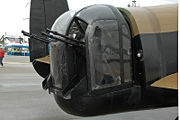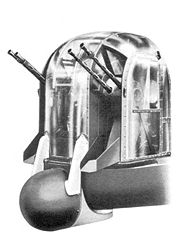
Nash & Thomson
Encyclopedia


Gun turret
A gun turret is a weapon mount that protects the crew or mechanism of a projectile-firing weapon and at the same time lets the weapon be aimed and fired in many directions.The turret is also a rotating weapon platform...
s for aircraft. The company was also an important manufacturer of hydraulic powered radar
Radar
Radar is an object-detection system which uses radio waves to determine the range, altitude, direction, or speed of objects. It can be used to detect aircraft, ships, spacecraft, guided missiles, motor vehicles, weather formations, and terrain. The radar dish or antenna transmits pulses of radio...
scanners, used on radar systems such as H2S
H2S radar
H2S was the first airborne, ground scanning radar system. It was developed in Britain in World War II for the Royal Air Force and was used in various RAF bomber aircraft from 1943 to the 1990s. It was designed to identify targets on the ground for night and all-weather bombing...
and AI Mark VIII.
History
Nash & Thompson was established in 1929 at Kingston upon ThamesKingston upon Thames
Kingston upon Thames is the principal settlement of the Royal Borough of Kingston upon Thames in southwest London. It was the ancient market town where Saxon kings were crowned and is now a suburb situated south west of Charing Cross. It is one of the major metropolitan centres identified in the...
by business partners Archibald Frazer-Nash
Archibald Frazer-Nash
Archibald Goodman Frazer Nash , was an early English motor car designer and engineer, who specialised in manufacturer of light and sports cars in England....
and E. Gratten Thompson and registered as a limited company in 1936. The company was formed to develop the turrets that Frazer Nash
Frazer Nash
Frazer Nash was a British sports car manufacturer and engineering company founded by Archibald Frazer-Nash in 1922. It produced sports cars incorporating a unique multi-chain transmission before World War II and also imported BMW cars to the UK. After the war it continued producing sports cars with...
had originated, and the designs were consequently numbered in a series prefixed with "FN".
The company's major competition in the UK was from Boulton & Paul which had licensed the designs of the French SAMM company. While the FN turrets used hydraulic power produced by the aircraft's engine, the BP designs used individual hydraulic pumps for each turret supplied from the aircraft's 24 volt electrical system.
Products

Hydraulic machinery
Hydraulic machines are machinery and tools that use liquid fluid power to do simple work. Heavy equipment is a common example.In this type of machine, hydraulic fluid is transmitted throughout the machine to various hydraulic motors and hydraulic cylinders and which becomes pressurised according to...
and carried 0.303 inch (7.7 mm)
.303 British
.303 British, or 7.7x56mmR, is a .311 inch calibre rifle and machine gun cartridge first developed in Britain as a blackpowder round put into service in December 1888 for the Lee-Metford rifle, later adapted to use smokeless powders...
Vickers K or Browning
M1919 Browning machine gun
The M1919 Browning is a .30 caliber medium machine gun that was widely used during the 20th century. It was used as a light infantry, coaxial, mounted, aircraft, and anti-aircraft machine gun by the U.S. and many other countries, especially during World War II, the Korean War, and the Vietnam War...
machine guns, except where noted. Many were built by Parnall Aircraft.
- FN-1 – "lobster back" partially enclosed turret for Hawker Demon
- FN-4A – four gun rear turret
- FN-5 – two gun nose turret on Avro LancasterAvro LancasterThe Avro Lancaster is a British four-engined Second World War heavy bomber made initially by Avro for the Royal Air Force . It first saw active service in 1942, and together with the Handley Page Halifax it was one of the main heavy bombers of the RAF, the RCAF, and squadrons from other...
, Avro ManchesterAvro Manchester|-See also:-References:NotesCitationsBibliography* Buttler, Tony. British Secret Projects: Fighters and Bombers 1935–1950. Hickley, UK: Midland Publishing, 2004. ISBN 978-1857801798....
, Short StirlingShort StirlingThe Short Stirling was the first four-engined British heavy bomber of the Second World War. The Stirling was designed and built by Short Brothers to an Air Ministry specification from 1936, and entered service in 1941...
and Vickers WellingtonVickers WellingtonThe Vickers Wellington was a British twin-engine, long range medium bomber designed in the mid-1930s at Brooklands in Weybridge, Surrey, by Vickers-Armstrongs' Chief Designer, R. K. Pierson. It was widely used as a night bomber in the early years of the Second World War, before being displaced as a... - FN-7 – two gun dorsal turret on Blackburn BothaBlackburn Botha-See also:-External links:*...
, Manchester, Short SunderlandShort SunderlandThe Short S.25 Sunderland was a British flying boat patrol bomber developed for the Royal Air Force by Short Brothers. It took its service name from the town and port of Sunderland in northeast England....
, Stirling - FN-9 – two gun retractable "dustbin" ventral turret on Wellington, rarely fitted.
- FN-10 – two gun tail turret on early-model Wellington and Armstrong Whitworth WhitleyArmstrong Whitworth WhitleyThe Armstrong Whitworth A.W.38 Whitley was one of three British twin-engine, front line medium bomber types in service with the Royal Air Force at the outbreak of the Second World War...
- FN-11 – two gun retractable nose turret in Sunderland
- FN-13 – four gun tail turret in Sunderland
- FN-16 – single Vickers 'K' gun front turret in Whitley
- FN-17 – two gun retractable "dustbin" ventral turret on Whitley, rarely used
- FN-20 – four gun tail turret on Lancaster, Wellington, Stirling, Wellington, Whitley
- FN-25 – two-gun ventral turret for the Wellington I based on the FN-17
- FN-50 – two gun dorsal turret ("Centre Gun Turret") on Lancaster, late-model Stirling
- FN-51 – two gun dorsal turret on early-model Handley Page HalifaxHandley Page HalifaxThe Handley Page Halifax was one of the British front-line, four-engined heavy bombers of the Royal Air Force during the Second World War. A contemporary of the famous Avro Lancaster, the Halifax remained in service until the end of the war, performing a variety of duties in addition to bombing...
- FN-54 – two gun rearward firing chin turret on Bristol Blenheim Mk.IVBristol BlenheimThe Bristol Blenheim was a British light bomber aircraft designed and built by the Bristol Aeroplane Company that was used extensively in the early days of the Second World War. It was adapted as an interim long-range and night fighter, pending the availability of the Beaufighter...
and Bristol BeaufortBristol BeaufortThe Bristol Beaufort was a British twin-engined torpedo bomber designed by the Bristol Aeroplane Company, and developed from experience gained designing and building the earlier Blenheim light bomber.... - FN-64 – two gun ventral turret ("Under Gun Turret") on Lancaster with periscopicPeriscopeA periscope is an instrument for observation from a concealed position. In its simplest form it consists of a tube with mirrors at each end set parallel to each other at a 45-degree angle....
sight, rarely fitted - FN-82 – two gun (0.5 inch (12.7 mm) Browning) tail turret on late-model Lancaster
- FN-120 – four gun tail turret. Refinement of the FN20 weighing 40 lb (18.1 kg) less. Used on late-model Lancaster
- FN-121 – four gun tail turret on late-model Lancaster fitted with Village InnVillage Inn (codename)The British Automatic Gun-Laying Turret was a radar-aimed FN121 turret fitted to some Lancaster and Halifax bombers in 1944. The AGLT system was devised to allow a target to be tracked and fired-on in total darkness, the target's range being accurately computed as well as allowing for lead and...
gun-laying radar - FN-150 – an improved two gun dorsal turret, based on the FN-50, and fitted to many Lancasters
A much more comprehensive list appears in Archie Frazer-Nash , Engineer (below).

